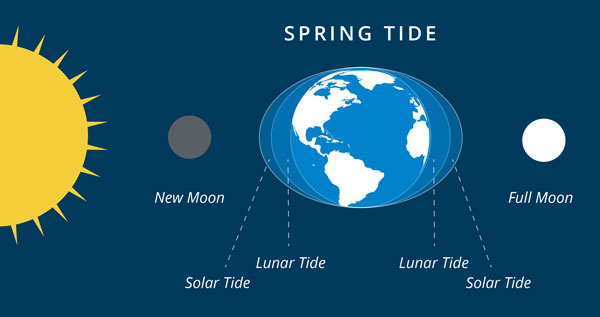Tides & Tidal Bores
Fundy Discovery Site is one of the most convenient and accessible places to experience the incredible tidal phenomena of Canada’s Bay of Fundy – home to the highest tides on Earth! A tidal bore occurs here on the Salmon River near Truro, Nova Scotia twice daily at predicted times offering a natural demonstration of the extremity of Fundy’s renowned tides. View LIVE Webcam
A tidal bore is a tumbling wavefront which moves upstream in a river, announcing the arrival of an incoming tide.
Tidal bores occur in regions of the world that have large tides. However, a tidal bore does not occur in every river flooded by a high tide.
Three conditions are necessary to form a tidal bore:
- Almost flat riverbed – The riverbed must have a very gentle, downstream slope.
- Higher riverbed – The riverbed must be well above the level of the low tide so that the tide is rising rapidly when it enters the part of the river where a tidal bore might appear.
- Shallow river water – The water in the river prior to the arrival of the bore must be relatively shallow. If a tidal bore encounters water that is much deeper than the height of the bore, the bore collapses into a barely noticeable, smooth surge of rising water.
Why does the size of the tidal bore in the Salmon River vary?
The largest tidal bores in the Salmon River occur on the days of perigean-spring tides (the Moon closest to Earth and at its new or full phase). Occasionally, because of much rain and/or rapid snow melt, the river may be too deep for a tidal bore to form. This is most likely to happen if the tide is a minimal apogean-neap tide (the Moon furthest from Earth and at its first- or last-quarter phase).
- Fundy Discovery Site: December 2024 – July 2025
- Truro (via Canadian Hydrographic Service website) Select time zone ADT for dates March 9 – November 1, 2025. Select time zone AST for dates before March 9 and after November 1, 2025.
Other Tide Times:
Why are Fundy tides so high? Resonance — like a push on a swing
Imagine a parent pushing their child on a swing. A gentle, repetitive push by the parent will sustain a large back-and-forth motion of the swing. The parent must time the pushes to closely match the natural period of the swing, a condition called resonance. If the timing is poor, the swing will not move much.
In the case of Fundy tides, the “swing” is the shallow body of water between the edge of the continental shelf east of Boston and the head of the Bay of Fundy. The “parent” is the small Atlantic tide at the edge of the continental shelf.
When a rising Atlantic tide crosses the edge of the continental shelf into the shallow Gulf of Maine, it travels as a long wave to the head of the Bay of Fundy, reflects, and returns to the edge of the continental shelf. When the wave reaches the edge of the shelf, the dramatic increase in ocean depth causes most of the wave to reflect again and travel back toward the head of the Bay of Fundy.
The time for this cycle is close to the 12.4-hour period of the lunar tide, which means that each Atlantic tide gives the previously reflected wave an almost perfectly timed push. It is that small, repetitive, well-timed push that drives Fundy’s tides near resonance, making them so large!
The vertical tidal range is the difference between low and high tide. In the Gulf of Maine/Bay of Fundy system, the vertical range of the tide is progressively larger toward the head of the Bay of Fundy, and largest in the Minas Basin.
The vertical tidal range is about 2 metres in the open Atlantic Ocean. Compare this with an average of 12 metres (40 feet) in the Minas Basin. It can even reach 16.5 metres (54 feet) on a perigean-spring tide!


A special thank you to Dr. Roy Bishop who provided technical assistance in the preparation of this content.
The Moon and Earth attract gravitationally, making them accelerate toward each other. Thankfully, they do not collide because they are moving sideways as they revolve together in their mutual orbit.
The ocean waters on the side of Earth nearest the Moon accelerate more than does Earth, creating a tidal bulge toward the Moon. Similarly, Earth itself accelerates more toward the Moon than do the waters on its far side, leaving those waters behind as a second tidal bulge. As Earth rotates beneath these tidal bulges, the usual two tides a day occur.
In a similar fashion, the Sun also causes tidal bulges on Earth. But because the Sun is much further away, its impact on the tides is much smaller than that of the Moon.
Did you know?
Tides are delayed by 50 minutes per day because the Moon orbits slowly in the same direction that Earth rotates.
Why does the tide range vary?
Phase of the Moon
As the Moon goes through its monthly cycle of phases, the lunar and solar pairs of tidal bulges get in and out of step. When in step at new and full Moons, the result is larger spring tides. When out of step at the quarter Moons, the result is smaller neap tides.
Closeness of the Moon
When the Moon moves around its elliptical orbit and is closest to Earth (perigee) the tides are larger. When the Moon is furthest from Earth (apogee) the tides are smaller.
Thus at any place on the oceans, the largest tides, known as perigean-spring tides, occur when the Moon is both close and at its new or full phase.
Fundy tides are unique in that they respond more to the perigee-apogee influence than they do to the spring-neap influence.

